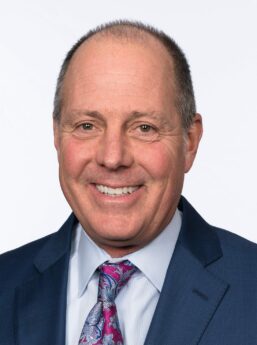HOME | ABOUT US | MEDIA KIT | CONTACT US | INQUIRE
HOME | ABOUT US | MEDIA KIT | CONTACT US | INQUIRE
Mike Bukaty and Mary Amundsen, sibling leaders for Bukaty Companies, wade headlong into the challenges their business clients, especially the smaller ones, face as the costs skyrocket for employer health benefits.
PUBLISHED JUNE 27, 2023

 Q. What are you seeing or hearing with health-insurance trends that should be of greatest concern to companies that want to provide these benefits?
Q. What are you seeing or hearing with health-insurance trends that should be of greatest concern to companies that want to provide these benefits?
AMUNDSEN: I think there is a lot of creativity in the marketplace right now, especially with a lot of new entrants. We used to refer to them as the BUCAs—Blue Cross, UnitedHealthcare, Cigna, Aetna—who you could go do as employers, but in the past couple of years, even last year, we’ve seen some creative carriers like 6 Degrees Health, for example, with a type of reference-based pricing product, using reimbursement rates based on a percentages of Medicare reimbursement levels, or companies like Gravie.
BUKATY: The way that pricing works is, if you find that Medicare pays $10,000 for a knee replacement, for example, and Blue Cross would pay $40,000, they say they’ll pay at 150 percent of Medicare. So they pay $15,000 in hopes the hospital accepts or that, or the vendor will then go to battle with the billing department to get them to accept it. You can see how that’s going to help drive costs down, but at some point, the hospital says “Wait a second, it may be OK when 3 percent of the claims coming in are through reference-based pricing, but as that catches on, we’re going to have to stop it.”
Q: What are the downsides of that process?
BUKATY: While those vendors fight tooth and nail and win most the time, hospitals are starting to say that if you have a reference-based product, you’re not coming through our doors, other than the ER. “Why would we schedule a procedure at $15,000 when we have patients lined up for months at $40,000?” Not everybody has caught on yet; maybe 2-3 percent are using it, but the more they use it, and the hospitals pay attention to the numbers, we’ll see more pushback.
Q: That can lead to some issues for employees after treatment, can’t it?
BUKATY: If I got into a hospital to get a knee replaced, and I get a bill that says I owe $40,000 but the insurance company sent $15,000 and I’m responsible for the balance, I have to take that letter to the employer or vendor and have them fight for me. A lot of folks don’t like to get those letters at home, so businesses have to train their employees to remain calm, not worry about thinking their credit is ruined. It’s not perfect by any means.
Q: In what other ways are insurers implementing change?
BUKATY: A lot are still using the PPO platform, but they are paying a lot for procedures people have held off on. If I had to have an MRI at $1,500 and decide not to because of the cost, then not follow up with my doctor, four years later my knee replacement might be eight times the cost. So you have some that are saying, let’s pay for up-front costs, doctor’s office costs beyond wellness checks, pay for the generic pharma, pay for that MRI or CAT scan, X-ray, blood or lab work, all at 100 percent. They believe it’s like dental care: You get your teeth cleaned twice a year, it keeps you out of the chair. If they can cover this stuff up front, it won’t turn into a big claim three or four years down the road.
Q: That’s a pretty big bet to be making, isn’t it?
BUKATY: Maybe, but we have eight or 10 groups with it, and the vendor is committing to a 7 percent rate increase, and they are delivering on 5-7 percent over the last 10 or 12 moths. The concept might be proving out, and it’s still early, but can see how it could make sense to get people healthier.
Q: Are there other innovations on the carrier end?
AMUNDSEN: The so-called captive plans have been around a long time, where business owners are sharing the risks. And carriers are staring to be more creative as well—policies with limited networks (and) plans that don’t pay for out-of-network care at all. Everybody is searching for ways to keep those costs down.
Q: So what factors are driving increases?
BUKATY: In a phrase, large claims, but break that down. We’re not going broke by doing tubes in kids’ ears, having their tonsils out, or even delivering babies. Those are always in line. What we are seeing now are procedures that run $500,000 to $1 million or more, fighting cancer, large claimants with gut or heart issues who 20 years ago, maybe that person would not have survived. Today, that person survives after being in the hospital 30 or 45 days. It’s not the nickel-and-dime claims catching up with carriers. It used to be about 80 percent of claims came from 25 percent of the people; now they’re coming from 14 or 15 percent.
Q: Any other cost drivers?
BUKATY: High-cost prescriptions especially with biosimilars. We have one group where a covered child needed a drug that cost $50,000 a month. How do you recoup $600,000 within a 40-person group? It’s with a large rate increase.
AMUNDSEN: It’s interesting how we’ve made tremendous advances in the medical field, but whether it’s with biologics or hospital machines that will do MRI, CT scans and X-rays all at once, those machines cost in the millions. So we’ve got these technological advances improving the quality of life, even the extension of life itself, but that comes with a very high cost.
Q: So as we look at overall costs for coverage a decade after its passage, did the Affordable Care Act deliver on its promise to rein in costs?
BUKATY: Our personal belief is that, no, it hasn’t. Let me give you some stats: About 90 percent of our groups here, maybe 95 percent, are on underwritten platforms. We go to carriers with a business plan, they get a chance to assess the risk factors and give us a price. The price we get 95 percent of the time is cheaper than plans established on the ACA, or the exchange. If 95 percent are getting a better deal with underwriting, those 5 percent, the higher risks, if you bring them back into the pool, I think you see more leveling out of premiums.
AMUNDSEN: Of course, ACA rates apply to groups under 50 people, but the underwriting formula has nothing to do with their health status. The biggest factor influencing rates is age. You can have rates three times higher for someone at age 59 than someone who is 24. That has hurt a lot of groups, and that’s why carriers got creative with level-funded plans, call it self-funded-lite, where they put bumper guards around plans to protect against a catastrophic financial blow. Carriers have done a lot to sidestep restrictive underwriting requirements; if the work force has an average age of 45 or 46, and you took the ACA rate, that insurance would be extremely expensive. Something else that has helped employees is the affordability rate. There’s a cap the IRS sets every year that limits how much employees have to pay for health care, and this year’s it’s 9.12 percent of household income.
Q: So how is all of this shaking out for small business owners, in particular, as they struggle to retain this vital employee benefit?
BUKATY: They are certainly going with higher deductible plans and those with higher out-of-pocket expenses. A lot are getting away from the traditional PPO and going with a high-deductible plan they can integrate a health-savings account. We shop our clients’ business every year to make sure there’s not something out there cheaper; if we can save 15 percent from Carrier A to Carrier B, we do that homework for clients. We’ll always give the incumbent carrier one last look, if they’re asking for 15 and the other guy is at 5, can you meet me at 10? That’s what employers are doing, but they say, “I’ve been with my carrier forever, but can you kick the tires for me with others? I’m willing to do whatever I have to do to keep costs in check.”
AMUNDSEN: There is a move to consumer engagement and price transparency. Carriers have adopted this approach, as well as new market entrants. Blue KC has its Smart Shopper program, where you can go online and look at doctors in your area code that do knee replacements, for example. Maybe eight or nine will pop up, and two or three will be low-cost or best cost with good outcomes. If you go to him vs. someone not doesn’t have that green tool indicator, you get money back in your pocket. That gets more attention than just “here’s a low-cost provider.”
Q: Tell us about the transparency advances.
BUKATY: The transparency tools are very cool, they are sophisticated, and carriers are now rewarding employers who use them. But those companies are making it work. They’re not taking away other benefits to pay for health coverage. If anything, they might be adding some second-tier benefits, like short-term disability or accidental death coverage.
AMUNDSEN: Costs are rising, but you have to remember that we’re in one of the most challenging times ever to hire and retain people. The benefits aren’t the over arching reasons that someone goes to work for a company, but they are looking at pay and benefits together. Employers know that to remain competitive, they have to offer a quality health package.
Q: The roots of that benefit go back to the World War II era, when employers limited in their ability to raise wages began offering health coverage as an inducement for talent. Was that a strategic mistake that needs to be unwound?
AMUNDSEN: I don’t think it was a mistake at all. The ACA gives everybody the opportunity to have health coverage, and some people can get it for zero dollars with the subsidy. Yet we still have 9.2 percent of the population that doesn’t have health insurance. In the workplace, more than 50 percent are getting it from their employer. If everyone were left to their own devices, you’d probably see rates of the uninsured go up significantly with people not having this basic understanding of the decisions they are making. I don’t always say if it ain’t broke, don’t fix it; there may be things that need to be looked at and that’s why we see transparency and consolidation of coverage in the industry. Industry, government and employers are working together, and they have to continue to do that to keep a lid on costs.